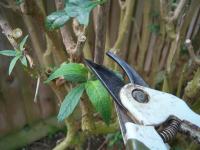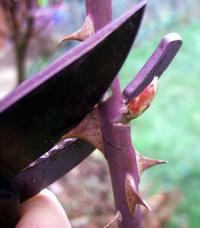How to Prune a Shrub
 A few simple guidelines can help you to prune any shrub
A few simple guidelines can help you to prune any shrubPruning shrubs can be a bit daunting for the novice gardener, but a few simple rules can help you on your way to safely prune ANY shrub.
Together with trees, shrubs form the framework and structure in our gardens that is so important especially during the winter months. The range of shrubs available for us to grow in our gardens is vast, there are both evergreen and deciduous types to choose from of all different sizes. Some are grown for their attractive foliage or bark, others for their flowers which are often scented and attractive to bees, butterflies and other insects.
Like all plants, shrubs flower well and remain in good health if we take the time to look after them. One of the most important aspects of looking after shrubs is pruning them properly.
Not all of us have had the horticultural training and the knowledge of the thousands of different shrubs that we need if we want to become expert in pruning them. This article is aimed at the beginner who might not even know the name of the shrub that they would like to prune in their garden or have any idea of how it should be done. When pruning shrubs, you can't really go too far wrong if you follow a few basic rules and principles.
Why do you Want to Prune?
Be clear in your mind; why do you want to prune the shrub, what is your aim? Is the shrub just getting too big?, are you trying to get it to produce more flowers? Maybe it is a shrub that is predominantly grown for it's attractive young bark and you need to encourage more young wood.
The Right Tools
Before you start pruning a shrub, make sure that you have the right tools. You will need a good sharp pair of secateurs for most of the pruning. For thicker stems a pair of loppers are useful. And for any stems that are still too thick for the loppers you will need a pruning saw.
Identify your Shrub
Pruning any shrub is so much easier if you are able to identify it first. If you know the name of the shrub you can then refer to a book about pruning for further help. When making each pruning cut, always look for a bud and cut just above it.
Pruning Evergreen Shrubs
As a rule, evergreen shrubs are much easier to prune than deciduous ones. This is because they don't really need much pruning at all! After the evergreen shrub has flowered, prune it to the desired shape, removing any wayward shoots. also remove any wood that appears dead, diseased or dying.
Pruning Deciduous Shrubs

With deciduous shrubs these can be split into three groups;
- Shrubs flowering on new wood, i.e. wood produced this year
- Shrubs flowering on old wood, i.e. wood produced last year
- Shrubs that are grown for their attractive young bark
New Wood
A shrub that produces flowers on the current year's wood e.g. Buddleja has to grow lots of nice young stems in a relatively short space of time, upon which the flowers are produced. To encourage the Buddleja to produce lots of new stems we prune it hard in March down to a level where young green shoots can still be seen.
Old Wood
A shrub that produces flowers on last year's wood e.g. Philadelphus should be pruned as soon as the flowers have faded, leaving any stems that have not flowered because these will flower next year.
Young Bark
A shrub that is grown for it's attractive young bark e.g. Cornus should be pruned in early spring after the display of bark has been fully appreciated (usually during the winter months). Such a shrub should be pruned hard, down to a few inches above ground level. The result is lots of new fresh shoots in time for next winter.
Of course the novice gardener, new to pruning might not be able to identify the age of the wood upon which the flowers are produced. If this is the case, just stick to only pruning when the shrub has finished flowering, and only prune the shoots that have flowered. At least then the shrub has a whole year to produce new wood that will flower at the same time next year and you also won't be removing any wood that will definitely flower next year.
Thining Out
In addition to pruning a shrub for the above reasons, it is also important to periodically thin out a shrub removing some of the older stems and also any that are crossing or rubbing against each other. This allows good airflow throughout the plant and therefore reduces the risk of some pests and diseases attacking.
The most important thing with pruning is to be brave, most shrubs will not die if you prune them incorrectly and remember in the wild; where shrubs grow without any human intervention they don't get pruned at all! Correct pruning however does undoubtedly optimise the number of flowers that are produced, the volume of new stems generated and it definitely has an impact on the overall health and well-being of the shrub.
Filed under Shrubs.

